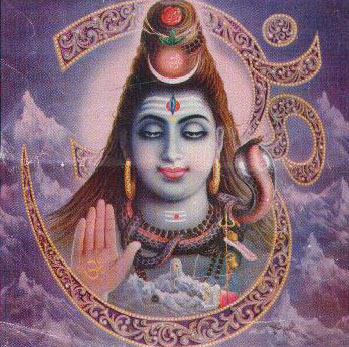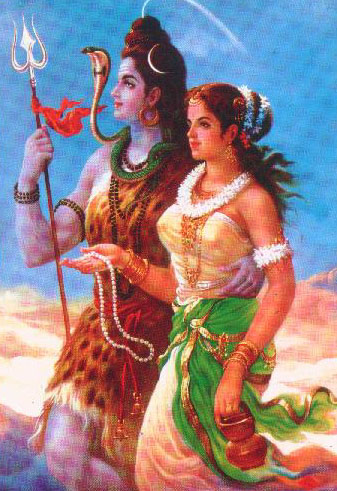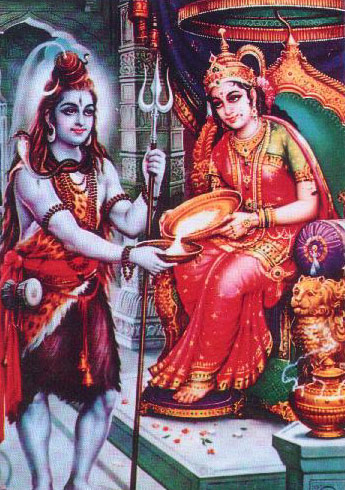Lord Shiva
Lord Shiva represents
the aspect of the Supreme Being (Brahman of the Upanishads) that continuously
dissolves to recreate in the cyclic process of creation, preservation,
dissolution and recreation of the universe. As stated earlier, Lord Shiva
is the third member of the Hindu Trinity, the other two being Lord Brahma
and Lord Vishnu.
Owing to His cosmic activity of dissolution and
recreation, the words destroyer and destruction have been erroneously associated
with Lord Shiva. This difficulty arises when people fail to grasp the true
significance of His cosmic role. The creation sustains itself by a delicate
balance between the opposing forces of good and evil. When this balance
is disturbed and sustenance of life becomes impossible, Lord Shiva dissolves
the universe for creation of the next cycle so that the unliberated souls
will have another opportunity to liberate themselves from bondage with
the physical world. Thus, Lord Shiva protects the souls from pain and suffering
that would be caused by a dysfunctional universe. In analogous cyclic processes,
winter is essential for spring to appear and the night is necessary for
the morning to follow. To further illustrate, a goldsmith does not destroy
gold when he melts old irreparable golden jewelry to create beautiful new
ornaments.
Lord Shiva is the Lord of mercy and compassion.
He protects devotees from evil forces such as lust, greed, and anger. He
grants boons, bestows grace and awakens wisdom in His devotees. The symbolism
discussed below includes major symbols that are common to all pictures
and images of Shiva venerated by Hindus. Since the tasks of Lord Shiva
are numerous, He cannot be symbolized in one form. For this reason the
images of Shiva vary significantly in their symbolism.
-
The unclad body covered with ashes: the unclad
body symbolizes the transcendental aspect of the Lord. Since most things
reduce to ashes when burned, ashes symbolize the physical universe. The
ashes on the unclad body of the Lord signify that Shiva is the source of
the entire universe which emanates from Him, but He transcends the physical
phenomena and is not affected by it.
-
Matted locks: Lord Shiva is the Master of
yoga. The three matted locks on the head of the Lord convey the idea that
integration of the physical, mental and spiritual energies is the ideal
of yoga.
-
Ganga: Ganga (river Ganges) is associated
with Hindu mythology and is the most sacred river of Hindus. According
to tradition, one who bathes in Ganga (revered as Mother Ganga) in accordance
with traditional rites and ceremonies on religious occasions in combination
with certain astrological events, is freed from sin and attains knowledge,
purity and peace. Ganga, symbolically represented on the head of the Lord
by a female (Mother Ganga) with a jet of water emanating from her mouth
and falling on the ground, signifies that the Lord destroys sin, removes
ignorance, and bestows knowledge, purity and peace on the devotees.
-
The crescent moon: is shown on the side of
the Lord's head as an ornament, and not as an integral part of His countenance.
The waxing and waning phenomenon of the moon symbolizes the time cycle
through which creation evolves from the beginning to the end. Since the
Lord is the Eternal Reality, He is beyond time. Thus, the crescent moon
is only one of His ornaments, and not an integral part of Him.
-
Three eyes: Lord Shiva, also called Tryambaka
Deva (literally, "three-eyed Lord"), is depicted as having three eyes:
the sun is His right eye, the moon the left eye and fire the third eye.
The two eyes on the right and left indicate His activity in the physical
world. The third eye in the center of the forehead symbolizes spiritual
knowledge and power, and is thus called the eye of wisdom or knowledge.
Like fire, the powerful gaze of Shiva's third eye annihilates evil, and
thus the evil-doers fear His third eye.
-
Half-open eyes: when the Lord opens His eyes,
a new cycle of creation emerges and when He closes them, the universe dissolves
for creation of the next cycle. The half-open eyes convey the idea that
creation is going through cyclic process, with no beginning and no end.
Lord Shiva is the Master of Yoga, as He uses His yogic power to project
the universe from Himself. The half-open eyes also symbolize His yogic
posture.
-
Kundalas (two ear rings): two Kundalas, Alakshya
(meaning "which cannot be shown by any sign") and Niranjan (meaning "which
cannot be seen by mortal eyes") in the ears of the Lord signify that He
is beyond ordinary perception. Since the kundala in the left ear of the
Lord is of the type used by women and the one in His right ear is of the
type used by men, these Kundalas also symbolize the Shiva and Shakti (male
and female) principle of creation.
-
Snake around the neck: sages have used snakes
to symbolize the yogic power of Lord Shiva with which He dissolves and
recreates the universe. Like a yogi, a snake hoards nothing, carries nothing,
builds nothing, lives on air alone for a long time, and lives in mountains
and forests. The venom of a snake, therefore, symbolizes the yogic power.
-
A snake (Vasuki Naga): is shown curled three
times around the neck of the Lord and is looking towards His right side.
The three coils of the snake symbolize the past, present and future - time
in cycles. The Lord wearing the curled snake like an ornament signifies
that creation proceeds in cycles and is time dependent, but the Lord Himself
transcends time. The right side of the body symbolizes the human activities
based upon knowledge, reason and logic. The snake looking towards the right
side of the Lord signifies that the Lord's eternal laws of reason and justice
preserve natural order in the universe.
-
Rudraksha necklace: Rudra is another name
of Shiva. Rudra also means "strict or uncompromising" and aksha means "eye."
Rudraksha necklace worn by the Lord illustrates that He uses His cosmic
laws firmly - without compromise - to maintain law and order in the universe.
The necklace has 108 beads which symbolize the elements used in the creation
of the world.
-
Varda Mudra: the Lord's right hand is shown
in a boon- bestowing and blessing pose. As stated earlier, Lord Shiva annihilates
evil, grants boons, bestows grace, destroys ignorance, and awakens wisdom
in His devotees.
-
Trident (Trisula): a three-pronged trident
shown adjacent to the Lord symbolizes His three fundamental powers (shakti)
of will (iccha), action (kriya) and knowledge (jnana). The trident also
symbolizes the Lord's power to destroy evil and ignorance.
-
Damaru (drum): a small drum with two sides
separated from each other by a thin neck-like structure symbolizes the
two utterly dissimilar states of existence, unmanifest and manifest. When
a damaru is vibrated, it produces dissimilar sounds which are fused together
by resonance to create one sound. The sound thus produced symbolizes Nada,
the cosmic sound of AUM, which can be heard during deep meditation. According
to Hindu scriptures, Nada is the source of creation.
-
Kamandalu: a water pot (Kamandalu) made from
a dry pumpkin contains nectar and is shown on the ground next to Shiva.
The process of making Kamandalu has deep spiritual significance. A ripe
pumpkin is plucked from a plant, its fruit is removed and the shell is
cleaned for containing the nectar. In the same way, an individual must
break away from attachment to the physical world and clean his inner self
of egoistic desires in order to experience the bliss of the Self, symbolized
by the nectar in the Kamandalu.
-
Nandi: the bull is associated with Shiva and
is said to be His vehicle. The bull symbolizes both power and ignorance.
Lord Shiva's use of the bull as a vehicle conveys the idea that He removes
ignorance and bestows power of wisdom on His devotees. The bull is called
Vrisha in Sanskrit. Vrisha also means dharma (righteousness). Thus a bull
shown next to Shiva also indicates that He is the etemal companion of righteousness.
-
Tiger skin: a tiger skin symbolizes potential
energy. Lord Shiva, sitting on or wearing a tiger skin, illustrates the
idea that He is the source of the creative energy that remains in potential
form during the dissolution state of the universe. Of His own Divine Will,
the Lord activates the potential form of the creative energy to project
the universe in endless cycles.
-
Cremation ground: Shiva sitting in the cremation
ground signifies that He is the controller of death in the physical world.
Since birth and death are cyclic, controlling one implies controlling the
other. Thus, Lord Shiva is revered as the ultimate controller of birth
and death in the phenomenal world.
- Bansi Pandit
Pictures

Bhagwan Shankar


Shiv-Parvati

Shiv-Parvati with Ganesh
|


















No one has commented yet. Be the first!